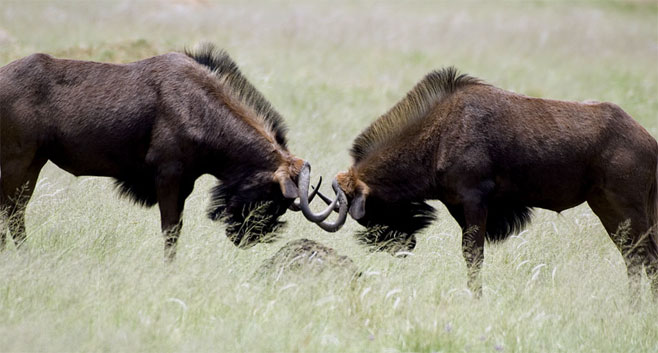|
Connochaetes gnou (Black wildebeest,
White-tailed gnu)
Swartwildebees
[Afrikaans]; Weisschwanz gnu [German]; gnou ŕ
queue blanche [French]; imbudumo,
imbuduma enzima [isiNdebele]; inqu, imbuthuma [isiXhosa]; inkonkoni, inkonkoni
enmyama [isiZulu]; podumô, pudumô [Sepedi]; pudumo, mmamononwane [Sesotho]; pudumô
[Setswana]; ingongoni [siSwati]; mbutuma [Xitsonga]; khongoni [Tshivenda]; gnu [Khoikhoi]
Life
>
Eukaryotes >
Opisthokonta >
Metazoa (animals) > Bilateria > Deuterostomia >
Chordata > Craniata > Vertebrata (vertebrates) >
Gnathostomata (jawed vertebrates) > Teleostomi (teleost
fish) > Osteichthyes (bony fish) > Class:
Sarcopterygii (lobe-finned fish) > Stegocephalia
(terrestrial vertebrates) > Reptiliomorpha > Amniota >
Synapsida (mammal-like reptiles) > Therapsida > Theriodontia
> Cynodontia > Mammalia (mammals)
> Placentalia (placental mammals) >
Laurasiatheria > Ferungulata > Cetartiodactyla (even-toed ungulates and cetaceans)
> Ruminantia (ruminants) > Family:
Bovidae (antelopes and buffalo) >
Subfamily: Antilopinae
Black wildebeest are endemic to southern Africa
and inhabit the open grassland and scrub woodland habitats, where
they graze on grass mainly. They have a characteristic nasal call
“ge-nu”, from which the common name gnu is derived. They are
dark-coloured with a distinctive white horse-like tail. Bulls defend
territories while cows and their young range freely through these
territories. There are also bachelor herds.
Identification
The black wildebeest is a one of the larger
antelopes, as its name suggests it is black in appearance although
the coat is really more dark brown than black. Its long white
horse-like tail contrasts with the dark body colour. This leads to
its alternative common name of white-tailed gnu. The shoulders are
markedly higher than the rump giving it a somewhat bizarre
appearance. An erect lighter coloured mane with a black fringe runs
from the shoulders to the top of the neck. The head is large with a
broad snout, and the face is covered in a brush-like tuft of hairs.
A fringe of long dark hair hangs from the throat and chest between
the front legs. The distinctive u – shaped horns bend steeply
downward from large bosses (bases) over the top of the head, and
then project forwards and upwards. Cows have thinner more lightly
built horns than the bulls.
Size
Shoulder height 1.2 m; weight 100 - 180
kg; average horn length 52 cm.
Dental Formula
I C C P P M M =
30 =
30
Distribution and habitat
Endemic to southern Africa: natural
distribution extends widely over Western Cape, Northern Cape,
Eastern Cape and Free State, the western region of KwazuluNatal and
northwards into the North West Province, Gauteng and Mpumalanga. Its
favoured habitat is open grassland and low scrubland with water
available.
General behaviour
During the hot summer days black wildebeest lie
up during the heat of the day, and limit their activity to the cool
periods in early morning and late afternoon. During winter when the
days are cooler, the midday rest period is reduced and the animals
are active for most of the day. They are also active before dawn and
after sunset.
Black wildebeest have a social herd structure
consisting of territorial males, female herds and bachelor groups.
Males defend territories and try to herd cows into their areas
during the breeding season (called a rut). Territories are marked
using urine, dung and scent secretions as well as elaborate displays
preformed by the bulls to attract the cows attention. Herds
consisting of cows and their young will range freely through the
bulls territories. Bachelor herds are made up of bulls of all ages.
 |
|
Black wildebeest males fighting, Kruger National
Park, South Africa. [photo Arno Meintjes
©] |
Food
Predominantly a grazer but it does browse
occasionally.
Reproduction
The gestation period is about 250 days with
births taking place in the middle of summer. A female gives birth to
a single calf, which is able to move with the herd within an hour of
its birth. The calf is born without horns, but has small straight
horns after 6 months. After about 2 years the characteristic u-shape
is evident and the horns are fully developed by the time the animal
is 4 years old.
Life span
21 years (maximum)
Conservation
Historically this species was widely
distributed and abundant, but its numbers were dramatically reduced
in the early 1900s when the black wildebeest was brought to the
brink of extinction by hunting and disease. It has since been widely
reintroduced to its original range and beyond it. Conservation
status is regarded as low risk, but the survival of the species is
conservation dependant.
Text by Denise Hamerton |
